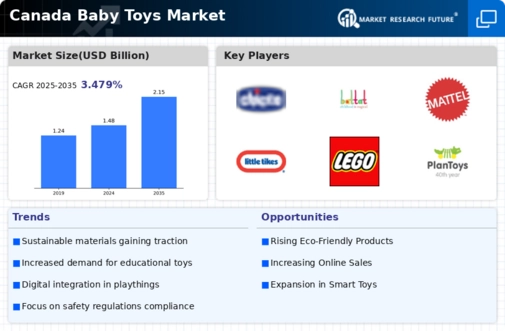Increased Focus on Safety Standards
The baby toys market is witnessing an increased focus on safety standards, driven by heightened consumer awareness and regulatory requirements. Parents are becoming more vigilant about the safety of the toys they purchase, leading to a demand for products that meet stringent safety guidelines. In Canada, regulatory bodies have implemented stricter safety regulations for children's toys, which manufacturers must comply with to ensure market access. This trend is likely to result in a significant shift towards safer materials and designs in the baby toys market. Companies that prioritize safety in their product development are expected to gain a competitive edge, as parents are more inclined to choose brands that demonstrate a commitment to child safety.
Growing Awareness of Child Development
There is a growing awareness among parents regarding the importance of child development, which is significantly impacting the baby toys market. Parents are increasingly seeking toys that not only entertain but also contribute to their child's cognitive, emotional, and physical growth. This trend is reflected in the rising demand for educational toys, which are designed to stimulate learning through play. In Canada, the market for educational baby toys is expected to expand by 12% in the coming years, as parents prioritize developmental benefits. This heightened awareness encourages manufacturers to innovate and create toys that align with developmental milestones, thereby enhancing their appeal in the competitive landscape of the baby toys market.
Rising Disposable Income Among Families
The baby toys market is significantly influenced by the rising disposable income among Canadian families. As household incomes increase, parents are more inclined to invest in high-quality, innovative toys that offer educational benefits. This trend is particularly evident in urban areas, where families are willing to spend more on premium products. According to recent data, the average spending on baby toys has increased by 20% over the past five years, indicating a robust market potential. This financial capability allows parents to prioritize safety, durability, and developmental value in their purchasing decisions. Consequently, manufacturers in the baby toys market are likely to focus on creating premium products that cater to the evolving needs of affluent consumers.
Technological Advancements in Toy Design
The baby toys market is experiencing a notable transformation due to technological advancements in toy design. Innovations such as interactive toys that incorporate artificial intelligence and augmented reality are becoming increasingly popular among parents. These toys not only entertain but also promote cognitive development in infants. In Canada, the demand for tech-integrated toys is projected to grow by approximately 15% annually, reflecting a shift in consumer preferences towards educational and engaging products. This trend indicates that manufacturers in the baby toys market must adapt to these technological changes to remain competitive. Furthermore, the integration of technology into toys is likely to enhance the overall play experience, making it more appealing to both children and parents alike.
Influence of Social Media and Online Communities
Social media and online communities are reshaping the baby toys market in Canada. Parents increasingly rely on social media platforms for recommendations and reviews of baby products, including toys. This trend has led to a surge in the popularity of influencer marketing, where trusted figures promote specific brands and products. As a result, companies in the baby toys market are investing in social media strategies to engage with consumers and build brand loyalty. Recent studies indicate that approximately 30% of parents make purchasing decisions based on social media recommendations, highlighting the importance of digital presence. This shift suggests that brands must adapt their marketing strategies to effectively reach and resonate with their target audience.






















Leave a Comment